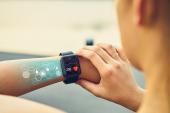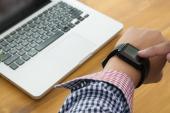Large Smartwatch Study Confirms AF in Most Patients Who Seek Care: mAF-App II
What remains to be seen is how this technology will affect outcomes and if it will be cost-effective, experts say.

WASHINGTON, DC—Among patients who saw a physician after downloading a smartwatch application and receiving notification of a potential heart rhythm issue, 93.8% were confirmed to have atrial fibrillation (AF), according to new data from the mAF-App II trial.
Enrolling more than 2.8 million Chinese participants who downloaded an AF screening app on a compatible Huawei smart device between 2018 and 2021, the study is the largest of its kind, and confirms data seen with similar investigations like the Apple Heart Study and Fitbit Heart Study. Furthermore, the researchers demonstrate the added ability to identify obstructive sleep apnea (OSA)—a known AF risk factor—with the same technology, and suggest the future potential of being able to more accurately pick up both conditions.
“Digital technologies make it possible to increase general awareness about AF and its risk factors as well as to improve prevention of AF and its complications,” Yutao Guo, MD (Chinese PLA General Hospital, Beijing, China), who presented the findings Sunday during a featured clinical research session at the American College of Cardiology 2022 Scientific Session, said in a press release. “With the global surge of wearable technology for AF screening, especially in the challenging setting of the COVID-19 pandemic, the present study provides a possible solution to help people identify possible signs of AF and get diagnosed and treated earlier.”
Commenting on the mAF-App II trial for TCTMD, Ioanna Kosmidou, MD, PhD (Memorial Sloan Kettering, New York, NY), said the study’s ability to enroll such a large population with good utilization is a “significant achievement.” But the big remaining question with all of these kinds of technologies relates to cost-effectiveness, she added. “It picked up very, very few events, and of those patients, they followed up with a cardiologist or an internist probably 50% of the time. This makes it even more interesting because one wonders why people would use the app and then not follow up if they have any suggestion that they need follow-up with a clinician.”
Kosmidou said the link between AF and OSA seen here is “worth noting,” especially because of the generally healthy population enrolled. “Obstructive sleep apnea, particularly untreated obstruct sleep apnea, has been a known risk factor for atrial fibrillation,” she explained. “It's largely [seen] in a specific patient population with a lot of comorbidities, including obesity. So demonstrating this in a vast general and young patient population, as it seemed, is actually quite important.”
Finding AF and OSA
For the study, Guo and colleagues enrolled 2,852,217 Chinese participants (mean age 37 years) with smartwatches that use photoplethysmography, a light-based method to monitor blood flow. The AF screening app detected an abnormal rhythm in 12,244 individuals and, of these, 5,227 chose to follow up with a clinician for further assessment. Among this cohort, 93.8% had AF confirmed (2.67% of the entire study population) using standard diagnostic tools including clinical evaluation, an electrocardiogram, and 24-hour Holter monitoring.
Further, of 961,931 of the app users screened for AF who were also assessed for signs of sleep apnea, 18,000 were notified they may have the condition and ended up having higher odds of an AF diagnosis (OR 1.51; 95% CI 1.30-1.75).
Discussing the study following its presentation, Jodie Hurwitz, MD (Medical City Hospital, Dallas, TX), said, “this is pretty impressive, first of all, to get a 93.8% confirmation of atrial fibrillation.” However, she noted the relatively young age of the patients enrolled in the trial. “Obviously, the group of patients or folks that we’d really like to get this into the hands of are much older,” she commented.
Additionally, Hurwitz said, “what will be really interesting is to see how this changes what we do clinically and what the outcomes are.”
Similarly, session co-chair Edward Fry, MD (St. Vincent Medical Group, Indianapolis, IN), called the results “fascinating, especially with the perspective of the scalability of these types of studies.”
Kosmidou said she would like to start seeing cost-effectiveness analyses for these types of technologies. “Also, despite having now a fair number of studies demonstrating how to be able to capture particularly silent A-fib episodes, especially in the young populations, through mobile app utilization, correlating this with long-term outcomes in order to establish such approaches as preventive therapies is going to be very important,” she said.
Until then, Kosmidou said physicians should not be recommending use of these apps and devices to their patients except for those who “already have comorbidities that may actually be due to atrial fibrillation or may be a consequence of silent atrial fibrillation.” The technology cannot be ignored because it has already penetrated the general population, she added, but “at this point, [they are not] the target population. . . . We do not have enough data.”
Yael L. Maxwell is Senior Medical Journalist for TCTMD and Section Editor of TCTMD's Fellows Forum. She served as the inaugural…
Read Full BioSources
Guo Y. Consumer-led screening for atrial fibrillation: a report from the mAFA-II trial long-term extension cohort. Presented at: ACC 2022. April 3, 2022. Washington, DC.
Disclosures
- The study was funded by the National Natural Science Foundation of China.
- Guo and Kosmidou report no relevant conflicts of interest.





Comments